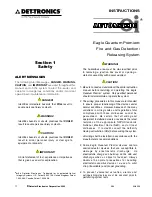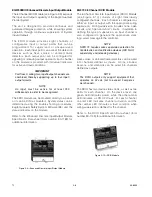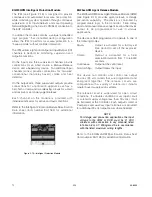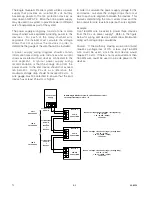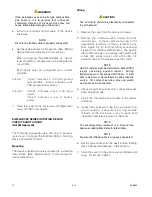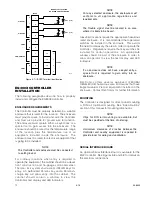
7.1
95-8533
2-12
EQ22xxiDC series initiating Device Circuit (iDC)
There are three IDC models available (see Figure 2-16):
The
EQ22xxiDC
allows discrete inputs from smoke/
heat detectors, manual call stations or other contact
devices.
The IDC accepts two dry contact inputs for use with
devices such as relays, pushbuttons, key switches,
etc. The IDC supports ANSI/NFPA 72 Class B, Style B
supervised input circuits
Each circuit requires its own end of line (EOL) resistor
for monitoring circuit continuity. Nominal resistance of
the resistor is 10 k ohms.
The
EQ22xxiDCGF
Initiating Device Circuit Ground
Fault Monitor (IDCGF) responds to the presence of a
ground fault within the power circuitry of the system.
It provides an unsupervised dry contact input and
ground fault monitoring circuitry for indicating a power
supply trouble condition. It is intended for use with a
third party power supply.
The
EQ22xxiDCsC
Initiating Device Circuit Short
Circuit (IDCSC) is similar to the IDC, but supports
ANSI/NFPA 72 Class B Style C supervised input
circuits. (Not FM Approved.)
Refer to the EQ22xxIDC Specification Data sheet
(form number 90-1121) for additional information.
Figure 2-16—Initiating Device Circuit
note
Input types (e.g. fire alarm, trouble, and gas
alarms) are configurable through Det-tronics
Safety System Software (S3).
EQ22xxDCu and EQ22xxDCuEX
Digital Communication units
The EQ22xxDCU Digital Communication Unit (DCU) is
an analog signal input device that accepts a 4 to 20
milliampere signal. The device is typically connected
to gas detectors, where the analog signal represents
the gas concentration.
Calibration of the DCU involves a non-intrusive
procedure that can be performed by one person at
the device without declassifying the area.
The device supports two alarm setpoints that are
defined as part of the device’s configuration setup.
When detecting combustible gases, the alarm
setpoints represent low and high gas alarm levels.
When detecting oxygen, the alarms represent the
range for the acceptable oxygen level. If oxygen
drops below the alarm range, a low alarm is
generated by the device.
PointWatch/DuctWatch IR gas detector as well as
electrochemical sensors (hydrogen sulfide, carbon
monoxide, chlorine, sulfur dioxide, and nitrogen
dioxide) are examples of devices that can be
connected to the DCU.
note
A catalytic sensor can be connected to a DCU
through a transmitter, which converts the millivolt
signal to a 4 to 20 milliampere signal.
The EQ22xxDCUEX is a specialized version of the
DCU that contains a transmitter for connection to a
Det-Tronics Model CGS catalytic combustible gas
sensor.
Refer to the EQ22xxDCU Specification Data sheet
(form number 90-1118) for additional information.
piRECL pointWatch Eclipse
For PIRECL installation, operation, maintenance,
specifications and ordering information, refer to form
number 95-8526.
note
the low alarm range for the eQP PIReCL is
5-40% LFL (the standard PIReCL is 5-60% LFL).
For information regarding USCG Approval of the
PIRECL Detector, refer to Appendix D.
opECL open path Eclipse
For OPECL installation, operation, maintenance,
specifications and ordering information, refer to form
number 95-8556.
Summary of Contents for DET-TRONICS 95-8533
Page 128: ...7 1 95 8533 A 4 Figure A 1 System Drawing 007545 001 ...
Page 129: ...95 8533 A 5 7 1 Figure A 2 System Drawing 007545 001 ...
Page 131: ...95 8533 7 1 B 2 Figure B 1 Drawing 007546 001 ...
Page 132: ...95 8533 7 1 B 3 Figure B 2 Drawing 007546 001 ...
Page 134: ...95 8533 7 1 C 2 Figure C 1 Drawing 007547 001 ...
Page 141: ...95 8533 7 1 D 7 Figure D1 System Drawing 007545 001 ...
Page 143: ...APPENDIX E E 1 95 8533 7 1 ...



